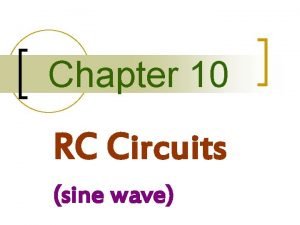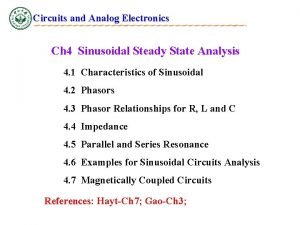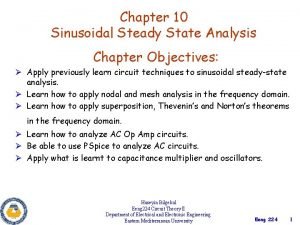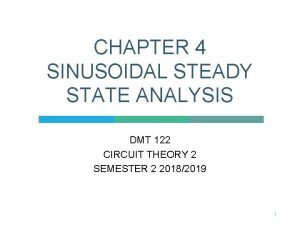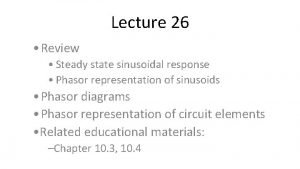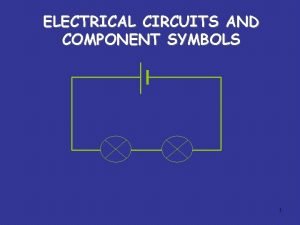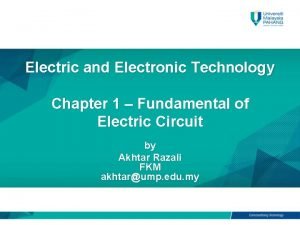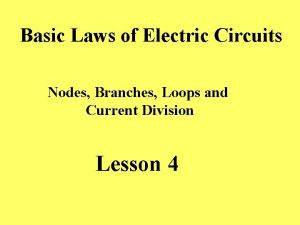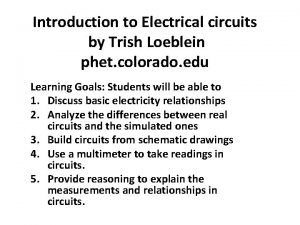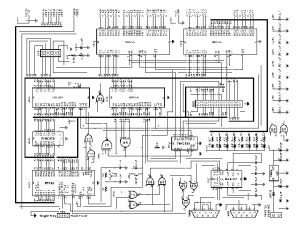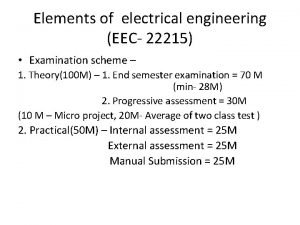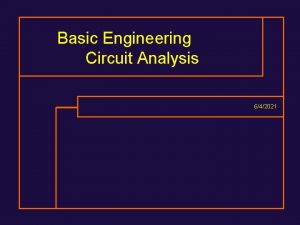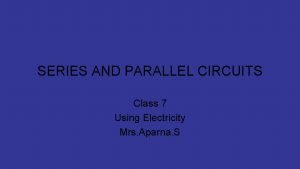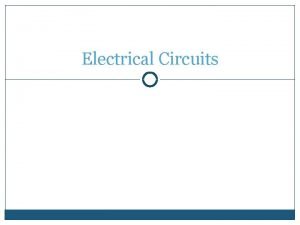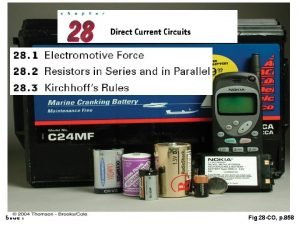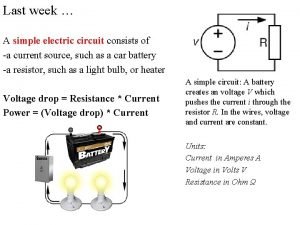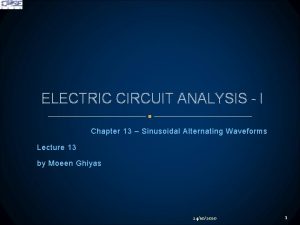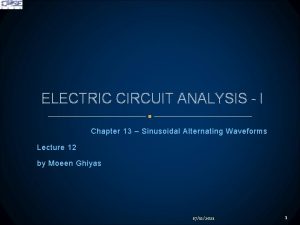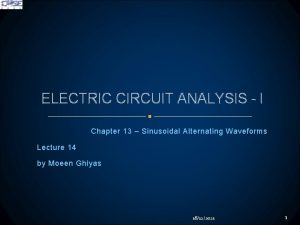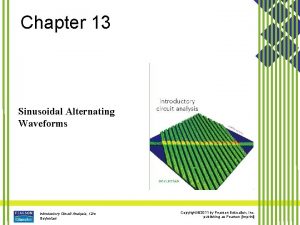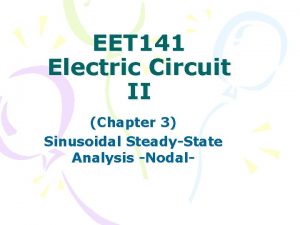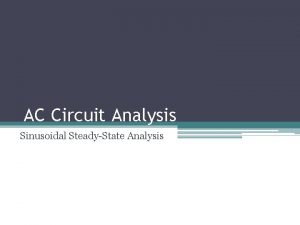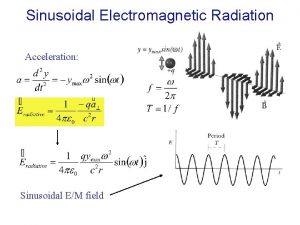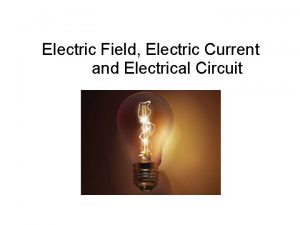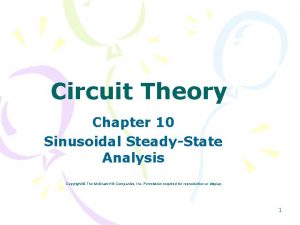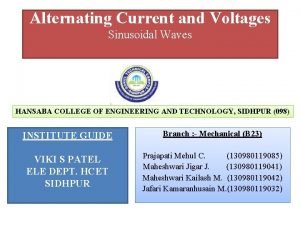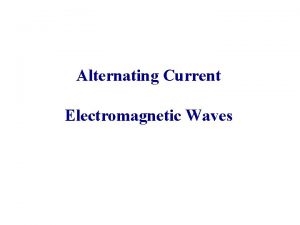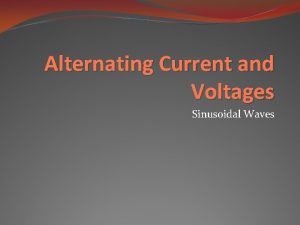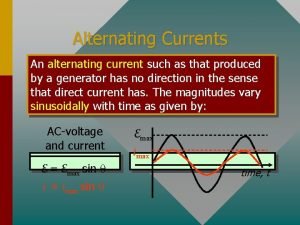ELECTRIC CIRCUIT ANALYSIS I Chapter 13 Sinusoidal Alternating









































- Slides: 41

ELECTRIC CIRCUIT ANALYSIS - I Chapter 13 – Sinusoidal Alternating Waveforms Lecture 14 by Moeen Ghiyas 16/12/2021 1

CHAPTER 13 – Sinusoidal Alternating Waveforms TODAY’S lesson

TODAY’S LESSON CONTENTS � Average Value � Effective (RMS) Value � Assignment # 3 � Application and Safety Concerns

Average Value �The longer the distance, the lower is the average value

Average Value � If the distance parameter includes a depression, as shown in fig. , some of the sand will be used to fill the depression, resulting in an even lower average value for the landscaper. � Similarly for a sinusoidal waveform, the depression would have the same shape as the mound of sand (over one full cycle), resulting in an average value at ground level (or zero volts for a sinusoidal voltage over one full period).

Average Value �For example, if a person travelled for 5 h, find the average speed and distance travelled? �= 245 /5 mi/h �= 49 mi/h

Average Value � Thus for any variable quantity, such as current or voltage, if we let G denote the average value

Average Value � Thus for any variable quantity, such as current or voltage, if we let G denote the average value � The average value of any current or voltage is the value indicated on a dc meter (or dc mode in DMM). � In the analysis of electronic circuits to be considered in a later course, both dc and ac sources of voltage will be applied to the same network. � In other words, average value indicates the dc component value in a sinusoidal alternating waveform.

Average Value � EXAMPLE - Determine the average value of the waveform of fig. � By inspection, the area above the axis equals the area below over one cycle, resulting in an average value of zero volts � Mathematically

Average Value � EXAMPLE - Determine the average value of the waveforms of Fig. Solution In reality, the waveform of fig. (b) is simply the square wave of fig. (a) with a dc shift of 4 V; that is,

Average Value � Using Area = 1/2 b x h for the area of a right-triangle we can approximate the area of a pulse with a single triangle � However, we can obtain a good approximation of the area of a half sine wave by attempting to reproduce the original wave shape using a number of small rectangles or other familiar shapes

Average Value � A closer approximation than a single triangle might be obtained by a rectangle with two similar triangles

Average Value �But calculus(integration) gives the best solution �Finding the area under the positive pulse of a sine wave using integration, we have Here dα indicates that we are integrating with respect to α.

Average Value �Since now we know the area under the positive (or negative) pulse, �we can easily determine the average value of the positive (or negative) region of a sine wave pulse by applying eq. Note the average is same for half pulse as for a full pulse

Average Value �Example – Determine the average value of the sinusoidal waveform of fig. �Solution

Average Value � Example – Determine the average value of the waveform of fig. � Solution - �. peak-to-peak value = 16 m. V + 2 m. V = 18 m. V peak amplitude = 18 m. V/2 = 9 m. V � Counting down 9 m. V from 2 m. V (or 9 m. V up from -16 m. V) results in an average or dc level of -7 m. V, as noted by the dashed line

Average Value �Example – Determine the average value of the waveform of fig. �Solution

Average Value � Measuring Average Value or dc component using oscilloscope by choosing DC – GND – AC option for vertical channel

Average Value � Measuring Average Value or dc component using oscilloscope by choosing DC – GND – AC option for vertical channel � Fig (a) AC option for vertical channel while fig (b) with DC option

Effective (rms) Value � Question arises, how is it possible for a sinusoidal ac quantity to deliver a net power (P=VI as in dc) if, over a full cycle, the net current in any one direction is zero (average value 0)? � However, understand that irrespective of direction (positive or negative), current of any magnitude through a resistor will deliver power to that resistor. � The power delivered at each instant will, of course, vary with the magnitude of the sinusoidal ac current. � Effective value (or rms value) co-relates dc and ac quantities with respect to the power delivered to a load. 16/12/2021 20

Effective (rms) Value � A fixed relationship between ac and dc voltages and currents can be derived from the experimental setup shown in Fig � If switches are closed alternately, a dc current I or i will flow as per ohm’s law. 16/12/2021 21

Effective (rms) Value � First the temperature reached by the water is determined by the dc power dissipated in the form of heat by the resistor. � Later the ac input ‘i’ is varied until the temperature is the same as that reached with the dc input. � When this is accomplished, the average electrical power delivered to the resistor R by the ac source is the same as that delivered by the dc source. 16/12/2021 22

Effective (rms) Value � The power delivered by the dc supply at any instant of time is P = VI = V 2/R = I 2 R � Thus � From Trigonometric identity � Therefore, � and 16/12/2021 23

Effective (rms) Value � The average power delivered by the ac source is just the first term, since the average value of a cosine wave is zero even though the wave may have twice the frequency of the original input current waveform. � Equating the average power delivered by the ac generator to that delivered by the dc source

Effective (rms) Value � The equivalent dc value is called the effective value of the sinusoidal quantity. � In summary � In other words, it would require an ac current with a peak value of √ 2(10) = 14. 14 A to deliver the same power to the resistor in fig. as a dc current of 10 A.

Effective (rms) Value � From above experiment, the effective value of any quantity plotted as a function of time can be found by � Thus, to find the effective value, the function i(t) must first be squared. � Next the area under the curve is found by integration. � It is then divided by time period T, to obtain the average or mean value of the squared waveform. � The final step is to take the square root of the mean value. � This procedure gives us another designation for the effective value, the root-mean-square (rms) value. 16/12/2021 26

Effective (rms) Value �EXAMPLE - Find the rms values of the sinusoidal waveform in each part of Fig �Note that frequency did not change the effective value in (b) above compared to (a).

Effective (rms) Value � Example – A 120 -V dc source of fig. (a) delivers 3. 6 W to the load. Determine peak value of the applied voltage (Em) and current (Im) if ac source fig. (b) is to deliver same power to load. 16/12/2021 28

Effective (rms) Value � Example – Calculate the rms value of the voltage of Fig. � Solution 16/12/2021 29

Effective (rms) Value �The rms values of sinusoidal quantities such as voltage or current will be represented by E and I. �These symbols are the same as those used for dc voltages and currents. �To avoid confusion, the peak value of a waveform will always have a subscript m associated with it as in Im 16/12/2021 30

Effective (rms) Value �When finding the rms value of the positive pulse of a sine wave, note that the squared area is not simply (2 Am)2 = 4 A 2 m; it must be found by a completely new integration. This will always be the case for any waveform that is not rectangular. 16/12/2021 31

Effective (rms) Value �A unique situation arises if a waveform has both a dc and an ac component. What is the rms value of the voltage v. T? �. Vac (rms) = 3/2 * 0. 707 = 1. 06 V 16/12/2021 32

Assignment # 3 �Ch 13 – Q. 1, Q. 8, Q. 16, Q. 24, Q. 31 fig (b), Q. 39 fig (a), Q. 39 and Q. 49 �Submission date & time: 09: 00 next week 16/12/2021 33

Application (220 V at 50 Hz) vs (120 V at 60 Hz) �Frequency selection? � 220 V vs 120 V? �DC vs AC?

Application (220 V at 50 Hz) vs (120 V at 60 Hz) � Frequency selection? Small difference so general agreement exists � Frequency selection originally focused on freq that would not exhibit flicker in the incandescent lamps available in old days. � Another important factor was the effect of frequency on the size of transformers; size of a transformer is inversely proportional to frequency. � The result is that transformers operating at 50 Hz must be larger (on mathematical basis about 17% larger) than those operating at 60 Hz.

Application (220 V at 50 Hz) vs (120 V at 60 Hz) � However, higher frequencies result in increased arcing, increased losses in transformer core due to eddy current and hysteresis losses, and skin effect phenomena. � Since accurate timing is such a critical part of our technological design, significant motive could have been the fact that 60 Hz is an exact multiple of 60 seconds in a minute and 60 minutes in an hour. � Whereas 50 Hz has close affinity to the metric system. Keep in mind that powers of 10 are all powerful in the metric system, with 100 cm in a meter, 100°C the boiling point of water, and so on. Note that 50 Hz is exactly half of this special number. � All in all, difference may have been simply political in nature.

Application (220 V at 50 Hz) vs (120 V at 60 Hz) � The difference in voltage (Almost 100% difference) � Larger voltages such as 220 V raise safety issues beyond those raised by voltages of 120 V. � However, when higher voltages are supplied, there is less current in the wire for the same power demand, permitting the use of smaller conductors—a real money saver. In addition, motors, compressors, and so on, found in common home appliances and throughout the industrial community can be smaller in size. � Higher voltages, however, also bring back the concern about arcing effects, insulation requirements, and, due to real safety concerns, higher installation costs.

Safety Concerns (High Voltages and dc versus ac) � For instance, under dry conditions, most human beings can survive a 120 -V ac shock such as obtained when changing a light bulb, turning on a switch, and so on. However, if hit by 220 V, the response (though still possible to survive) will be totally different. � For voltages beyond 220 V rms, the chances of survival go down exponentially with increase in voltage. It takes only about 10 m. A of steady current through the heart to put it in defibrillation. � In general, therefore, always be sure that the power is disconnected when working on the repair of electrical equipment. � Never use extension cords or plug in TVs or radios in the bathroom or wet places.

Safety Concerns (High Voltages and dc versus ac) � AC vs DC � You have probably seen in movies or comic strips that people are often unable to let go of a hot wire � If you happen to touch a “hot” 120 -V ac line, you will get a good sting, but you can let go. But in case of a dc line, you will probably not be able to let go, and a fatality could occur.

Summary / Conclusion �Average Value �Effective (RMS) Value �Application and Safety Concerns

16/12/2021 41
 Kaligrafi bismillah
Kaligrafi bismillah A suitable electric pump in an electric circuit is a
A suitable electric pump in an electric circuit is a Ac circuit
Ac circuit Sinusoidal response of rc circuit
Sinusoidal response of rc circuit S-domain circuit
S-domain circuit Chapter 21 electric charge and electric field
Chapter 21 electric charge and electric field Chapter 21 electric charge and electric field
Chapter 21 electric charge and electric field Coulombs units
Coulombs units Units of a charge
Units of a charge Chapter 23 electric current circuit happenings
Chapter 23 electric current circuit happenings Complex impedances
Complex impedances Sinusoidal steady state analysis practice problems
Sinusoidal steady state analysis practice problems Sinusoidal steady state analysis
Sinusoidal steady state analysis Steady state sinusoidal analysis using phasors
Steady state sinusoidal analysis using phasors Chapter 7 alternating current
Chapter 7 alternating current Equation for electric potential
Equation for electric potential Potential energy due to point charge
Potential energy due to point charge Electric field lines
Electric field lines Electric potential and electric field
Electric potential and electric field Electric charges and electric forces lesson outline
Electric charges and electric forces lesson outline Circuit electric cu 3 becuri
Circuit electric cu 3 becuri Symbols for some electric circuit components
Symbols for some electric circuit components Kirchoffs current law
Kirchoffs current law Branches electrical circuit
Branches electrical circuit Sistem penyaluran tenaga listrik
Sistem penyaluran tenaga listrik Phet circuit construction kit
Phet circuit construction kit Electric circuit analogy
Electric circuit analogy Eec 22215
Eec 22215 Brass paper fastener conductor or insulator
Brass paper fastener conductor or insulator Principles of electric circuits
Principles of electric circuits Electric circuit elements
Electric circuit elements How to make electric circuit for class 7
How to make electric circuit for class 7 Parallel circuit
Parallel circuit Flashlight electrical circuit
Flashlight electrical circuit Circuit
Circuit El circuit electric
El circuit electric Electric circuit consists of
Electric circuit consists of Electric fuse and circuit breaker graphic organizer
Electric fuse and circuit breaker graphic organizer Is a brass paper fastener a conductor or insulator
Is a brass paper fastener a conductor or insulator Electric circuit
Electric circuit Series vs paralle
Series vs paralle Different types of circuits
Different types of circuits



